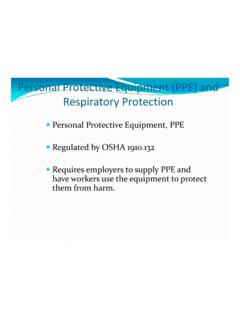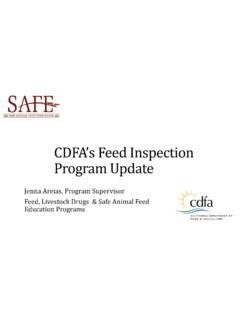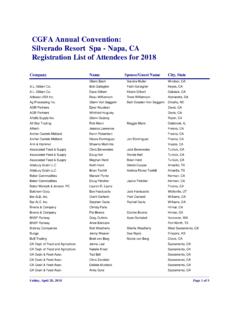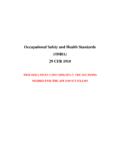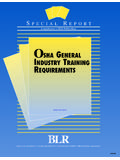Transcription of Overview of Grain handling Standards 1910
1 Overview of Grain handling Standards James Maness CGFA/NGFA Safety Seminar Fresno, CA. October 10, 2012. osha Citations and Emphasis Local Emphasis Programs Grain handling facilities Mechanical power transmission apparatus Guarding floor and wall openings and holes Permit required confined spaces Electrical Wiring methods and components Hazard Communication Respiratory Protection Lockout/Tagout of equipment Fixed Ladders Electrical, General Requirements osha Most Frequent Citations of Grain handling Standards J01 No written housekeeping program for dust. G01 I Did not issue a permit prior to entering the bin. G01 II Failure to lockout equipment in a bin prior to entry.
2 G04 Did not have rescue equipment suitable for the bin. E02 Did not train workers for special tasks, (bin entry). G02 No lifelines and harnesses for employees entering the bin. J02 II Did not immediately remove dust accumulations D failure to implement an emergency action plan. G01 III Failure to test the atmosphere within a bin before entry. M03 Failure to maintain certification record of PM/inspections. Fires & Dust Explosion Hazards Dust Explosions We have had great success to eliminate or control fires and dust explosions in our industry since 1977 78. However, we cannot relax our guard as the threat of explosions will always be with us.
3 Recent Sugar dust Explosions in Port Wentworth, GA and in other industries have brought more government action to try to remedy explosion causes. Dust Explosion Elements FUEL - Grain dust - Powdered food product - Explosive dust clouds resemble a very dense fog - Dust layers can be thrown in suspension causing more intense secondary explosions IGNITION SOURCE OXYGEN. - Must exceed minimum ignition - Air is everywhere energy and temperature - Supression can interfere o o [over 400 F (204 C)] with the explosion reaction 2. (Halon, CO chemical 2. - Typical Sources powder, H O). - open flames (lighters, matches, - Normally not practical fires, burning cigarettes).
4 - electrical sparks and failures - hot surfaces - overheated bearings - slipping bucket elevator belts or v-belts - improper welding and cutting - grinding or equipment sparks - foreign objects CONTAINMENT/ENCLOSURES. - Eliminate containment - open structures - explosion venting - outside location of critical equipment (legs, filter, etc.). - separation of buildings - Build to withstand explosion Houston Before Houston After J. Maness 1/29/10. Westwego JE Maness A1/29/10. Galveston J. Maness 1/29/10. J Maness 1/29/10. Georgia Sugar explosion 2008. February 7, 2008, Sugar Dust Involved 14 Killed, Over 40 Injured 90. 84. 82. 80.
5 Agricultural Dust Explosions 70. 65 1976-2005. 62. 60. 50. 50 47. 45. Number of Occurrences 40. 35. 29. 30. 23 24. 22 2221 23. 21 20 20. 19 19 18 19 19. 20 18. 16 15 15 14 16 18. 14. 1314 14 14 13 14. 13 12 13 12 12 12 12 13. 11. 11 10 11. 10 9 9. 10 8 8 8 88 88. 7 7 7 6 7 7 7 6. 4 4 4. 2 2 2 1 1 2 1 1 1 1 1 1 1 2 2. 0 0 0 0 0. 0. 1976 1978 1980 1982 1984 1986 1988 1990 1992 1994 1996 1998 2000 2002 2004. Explosions Injuries Fatalities -J .Maness 1/29/10. Secondary Explosions cause View After the the most damage. explosion July 2000. Grain Dust Explosion Factors Grain elevators Feed mills Corn Processors Flour mills Feed Elevators Rice mills Others.
6 J. Maness 1/29/10. Grains Involved in Explosions Corn Sorghum Other Wheat Starch Corn Soybeans Rice Corn Starch Barley Others J. Maness 1/29/10. Probable Location of Primary Explosions for a 27 Year Period Unknown Bucket Elevator Bins and Tanks Grinding Equipment Dust Collector Other areas inside elev. inside other equipment Headhouse Adjacent or attached Feed Mill Other J. Maness 1/29/10. Management Practices Emphasize good housekeeping (Written plan with daily inspections). Have a comprehensive Maintenance Program Utilize safe hotwork procedures Establish an emergency procedure plan Review Company Training program Ensure good safety communication Enforce Safety Rules Install safety devices slow down devices or plug switches where needed.
7 Have a program to deal with outside contractors Emergency Action Plan See the suggested model plan in the emergency action tab. If you have less than 10 employees you do not have to have a written EAP but must cover all the elements outlined in orally with employees. Emergency Action Plan Establish an evacuation alarm and methods to contact fire department Designate escape routes, responsibilities and procedures Have an assembly area and account for personnel. Train workers an others as needed in the plan. Meet with and include the fire Department and emergency responders in the plan. Emergency Action Plan Develop floor plans with exits shown, fire extinguishers, chemical storage rooms, emergency ladders, etc.
8 Emergency Action Plan Use a site drawing to show emergency exit paths and assembly areas , chemical storage, water sources, alarm methods. Share with the FD. on an invited visit. Why Training All employees are to know how to perform their jobs safely. They need to know about material, equipment, hazards, and control method. Training is critical to new employees. Employee's right to know = responsibility to follow safety. Supervisors must be trained and serve to reinforce training and enforce proper and safe work methods. (refresh and discipline). Supervisors right to be trained= Responsibility to train and enforce. Employers are obligated to provide a safe and healthy workplace.
9 Employers must have a method to ensure training is done. In many cases training must be documented. Employers must provide the resources and training to do the job safely = protection from fines, law suits and accidents. When is Training Needed? New and reassigned employees and workers When new equipment or processes are introduced. When new procedures are developed. When new information / knowledge is made available. When accidents and injuries show a lack of training When employee performance needs to improve. Examples of Required Training * GHS annual training required Access to Medical Records Personal Protective *Bin Entry (cleaning bins)
10 Equipment Bloodborne Pathogens Pesticide Application Confine Space *Emergency Response/Rescue Electrical Work Practices Respiratory Protection *Emergency Action Plan Truck Dumper Operation Fall Protection Equipment Rail Operations Safety First Aid *Welding/Cutting/ Hotwork Employee Orientation Grain handling Equipment Use of Fire Extinguishers *Planned Maintenance Forklift Operator Process Safety Management Front end Loader/Bobcat River Operations Safety Hazard Communication Storage and handling of LP Gases Hearing Protection Storage and handling of Manlifts Anhydrous Ammonia *Lockout and Tagout Exposure to Asbestos, lead, *Explosion Hazards and other chemicals as appropriate prevention.
